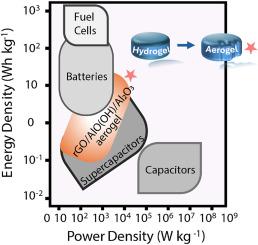Design and optimization of binder-free rGO/AlO(OH)/Al2O3 aerogels for energy storage
IF 7.9
3区 材料科学
Q1 GREEN & SUSTAINABLE SCIENCE & TECHNOLOGY
引用次数: 0
Abstract
This work reports a facile hydrothermal synthesis of reduced graphene oxide/aluminium oxide hydroxide/aluminium oxide (rGO/AlO(OH)/Al2O3) hydrogels without the use of external reducing agents. The resulting hydrogels were transformed into stable, binder-free aerogels via freeze-drying, yielding compact, porous materials with enhanced physicochemical and electrochemical properties. The incorporation of aluminium-based compounds boosted surface reactivity, mechanical stability, and electrolyte interaction of the composite. The aerogels exhibited a high surface area (261 m2 g−1) and a permeable microstructure, ideal for supercapacitor (SC) electrodes. Among various compositions, the sample with a 1:1 wt ratio of graphene oxide to Al(NO3)3·9H2O (SAlGH-2) delivered the best electrochemical performance, achieving in a symmetric two-electrode SC a specific capacitance of 131.5 F g−1, an energy density of 36.5 Wh kg−1, and a power density of 328.8 W kg−1 at a scan rate of 5 mV s−1. In parallel, a COMSOL Multiphysics model incorporating pseudocapacitive and electrochemical double-layer capacitance (EDLC) processes provided insights into ion diffusion and interfacial charge storage behaviour during cyclic voltammetry. This performance stems from the synergistic effect of rGO's electric double-layer capacitance, the conductivity and pseudocapacitance of AlO(OH)/Al2O3, and the aerogel's hierarchical porous structure. The SC demonstrated excellent durability, with 95.5 % coulombic efficiency and 76 % specific capacitance retention after 10,000 cycles. Structural, spectroscopic, and morphological analyses further validated the aerogel's integrity, underscoring its potential as a high-performance electrode material for advanced energy storage systems.

无粘结剂rGO/AlO(OH)/Al2O3储能气凝胶的设计与优化
本文报道了一种不使用外部还原剂的水热合成还原性氧化石墨烯/氢氧化铝/氧化铝(rGO/AlO(OH)/Al2O3)水凝胶的方法。所得的水凝胶通过冷冻干燥转化为稳定的无粘合剂气凝胶,得到致密的多孔材料,具有增强的物理化学和电化学性能。铝基化合物的掺入提高了复合材料的表面反应性、机械稳定性和电解质相互作用。气凝胶具有高表面积(261 m2 g−1)和可渗透的微观结构,是超级电容器(SC)电极的理想材料。在各种成分中,氧化石墨烯与Al(NO3)3·9H2O (SAlGH-2)重量比为1:1的样品具有最佳的电化学性能,在对称双电极SC中,扫描速率为5 mV s−1时,比电容为131.5 F g−1,能量密度为36.5 Wh kg−1,功率密度为328.8 W kg−1。同时,COMSOL Multiphysics模型结合了赝电容和电化学双层电容(EDLC)过程,提供了循环伏安法中离子扩散和界面电荷存储行为的见解。这种性能源于氧化石墨烯的双电层电容、AlO(OH)/Al2O3的电导率和赝电容以及气凝胶的分层多孔结构的协同效应。在10,000次循环后,SC具有95.5%的库仑效率和76%的比电容保持率。结构、光谱和形态分析进一步验证了气凝胶的完整性,强调了其作为先进储能系统高性能电极材料的潜力。
本文章由计算机程序翻译,如有差异,请以英文原文为准。
求助全文
约1分钟内获得全文
求助全文
来源期刊

Materials Today Sustainability
Multiple-
CiteScore
5.80
自引率
6.40%
发文量
174
审稿时长
32 days
期刊介绍:
Materials Today Sustainability is a multi-disciplinary journal covering all aspects of sustainability through materials science.
With a rapidly increasing population with growing demands, materials science has emerged as a critical discipline toward protecting of the environment and ensuring the long term survival of future generations.
 求助内容:
求助内容: 应助结果提醒方式:
应助结果提醒方式:


